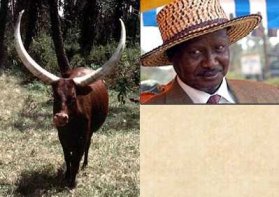UPC External Bureau Victoria, British Columbia
Who Fenced my Cow-path?
This is a parable Yaweri Kaguta Museveni (a cattle lover) can relate to.
A Cattle rancher's application of Change Management theory

We recently attended a Regional Transformation Team workshop in Texas. A large portion of the workshop dealt with Change Management and Continuous Improvement principles. We heard about Bridges, Kubler-Ross, Sloan, Deming and other well-known theorists of Continuous Improvement and Change Management.
All the expertise aside, I tried to place the behavioural patterns where I could understand them and shared a Change Management story of my own. With respect to the authors of the popular book, "Who moved the Cheese?", I entitle this rendition "Who Fenced my Cow-path?" Our family owns and operates a small cow-calf operation in Texas. We produce hay and about 15-18 calves on an annual basis.
Cows are creatures of habit and set in firm behavioural patterns. Where they walk, graze and sleep is similar from year to year. The herd of Herefords that is presently on the farm are descendants of an original herd that was first bought in the mid-1950's. The trails are well embedded and used regularly throughout the year.
For the past four decades, the cows have walked on one path in front of our home every winter to travel to and from their sleeping quarters under a grove of Spruce trees to the area where they are fed. They walk to the feeding area at about 4:00 am, are fed at 5:30 am, eat and hang out till mid afternoon when they return to the trees.
We have wanted to change this route due to the constant encountering of cow manure where the cow trail crosses our walking trail to the house. Building this into a practical test of change management theories, we fenced this cow-path forcing the cows to choose a new path around our house to get to the hay-pile.
At first the cows responded and found a new path (ya hoo!). This lasted until the temperature dipped down to 15 degrees a few weeks ago. After the early morning feed, I found the cows standing at the fence on the old path and voicing complaints while observing the hay-pile. They would not move onto the new path themselves.
Having shipped some of the elderly members (leaders) of the herd to the auction yard in the fall, there was confusion among the cows on who would lead.
I first started to coerce the cows onto the new path. There was hesitation, some started back to the trees while others milled around anxiously.
Thinking about the change management theories, I found a change leader who I then chased up the path. Once the change leader was on its way most of the herd followed. The rest of the stragglers needed to be coached one on one.
Some needed more coaching than others.
In the end the herd has established a new path or pattern of travel toward the hay-pile and the stress of change has been overcome.
Even though we are not managing cows, application of "complex" change management theories can be utilized in practical examples.
Learning and Strategic Lessons
- Sometimes one has to fence the cow-path to achieve another goal.
- Ensure the current path is not too deeply imbedded, it may need to change.
- The hay-pile or "Vision " must continue to be clear, visible and recognizable for a path to be chosen and followed by the organization. (What happened to the 10-point program?)
- The vision must be something you can sink your teeth into.
- Without a new path to carry out the vision, the organization may just turn in circles and complain.
- Without clear leadership and commitment, some will just "go back to bed."
- There is usually a leader in the herd, sometimes they need to be sought out.
- Plan for leadership succession, don't wait until the current leaders are headed down the road on the truck (in a coffin). (the NRM lacks a succession plan)
- Some follow the Leader, others resist change and need to be coached a little more.
- Sometimes the new path can be found by the group, other times it needs to be pointed out.
- Don't celebrate success too early, any new stress can derail the change.
- Communicate the change and show the potential path through good information.
- The acceptance and rate of change differs among the members of any group.
- If the vision is clear and the new path is communicated well, the organization will succeed.
The moral of this story is that the NRM has changed its vision from the 10-point program to something only one man knows. The followers do not understand what the new vision is, except that one man claims to have it.
Out of the confusion a new leader of the NRM diehards has arisen, and with time he will gradually subsume the NRM followers.
We in the UPC have always had a clear vision embedded in the part constitution. What is our vision?
"To fight poverty, illiteracy, and ignorance, and to ensure that all Ugandans are treated as equals without bias or prejudice."
The party constitution might not use those exact words, but that is the essence of the vision. We do not waffle around, and our vision does not necessarily depend on who is leading the party. Our distinguished late president Dr. Apolo Milton Obote was a visionary, and he epitomized the vision of the party. Therein lies our strength.
Long live the people of Uganda. Long live Mama miria Kalule Obote. Long live UPC.
 Radio Rhino
Radio Rhino